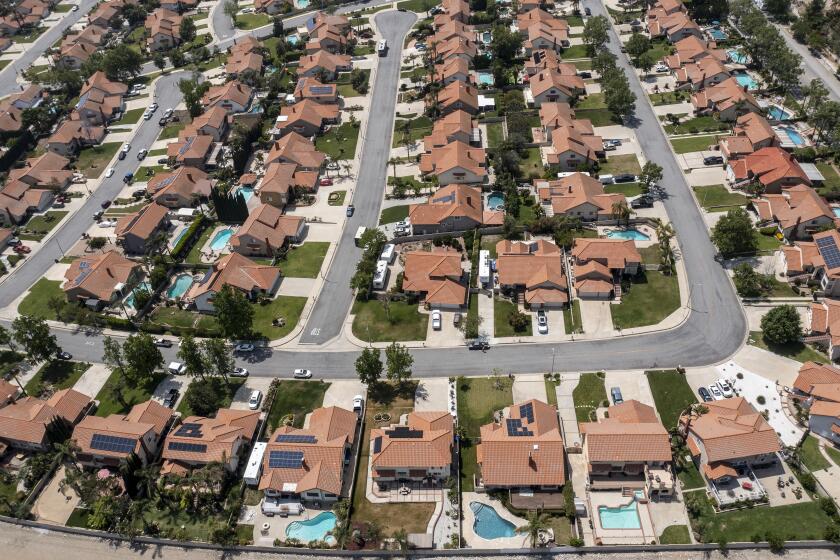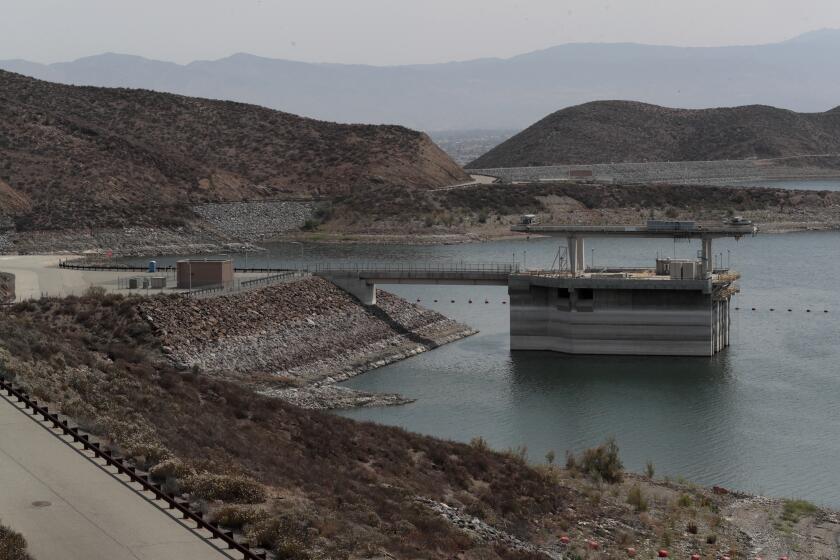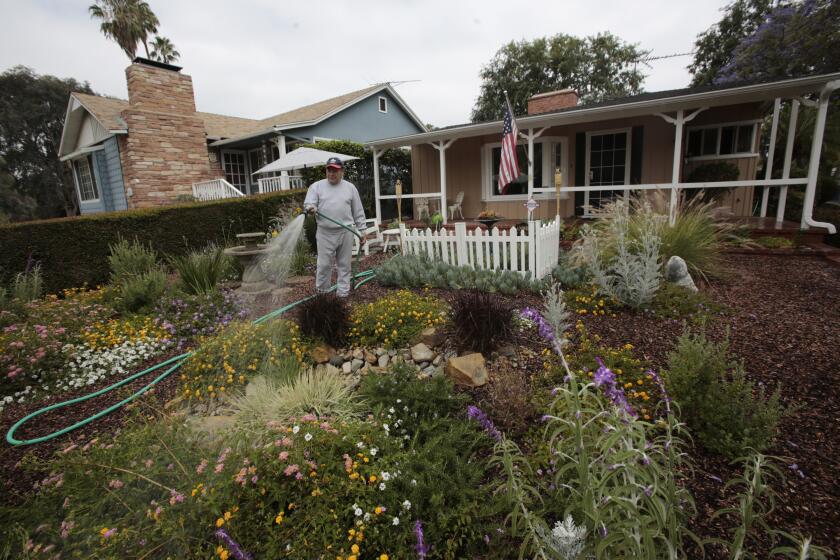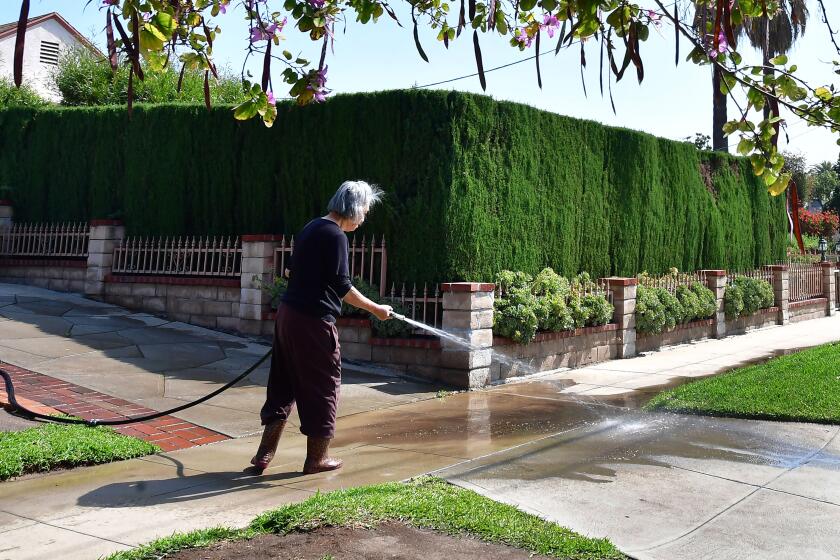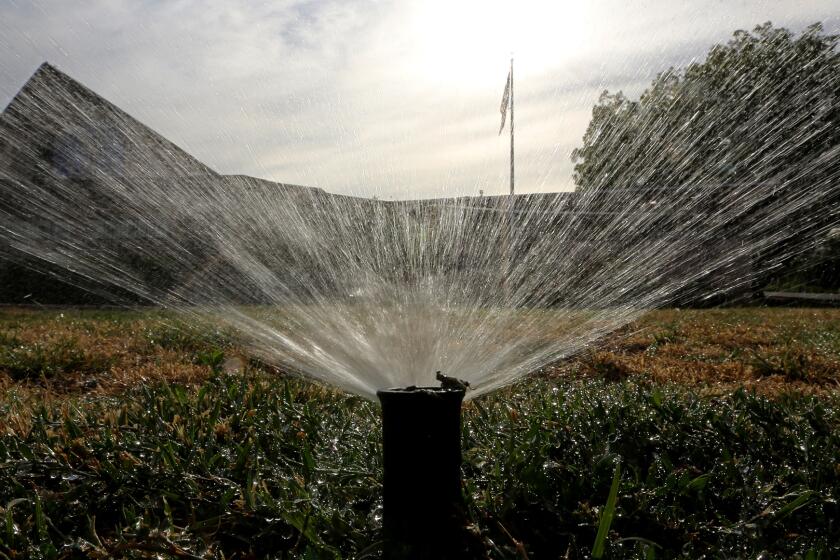Why some SoCal neighborhoods face dire water cuts while others escape restrictions
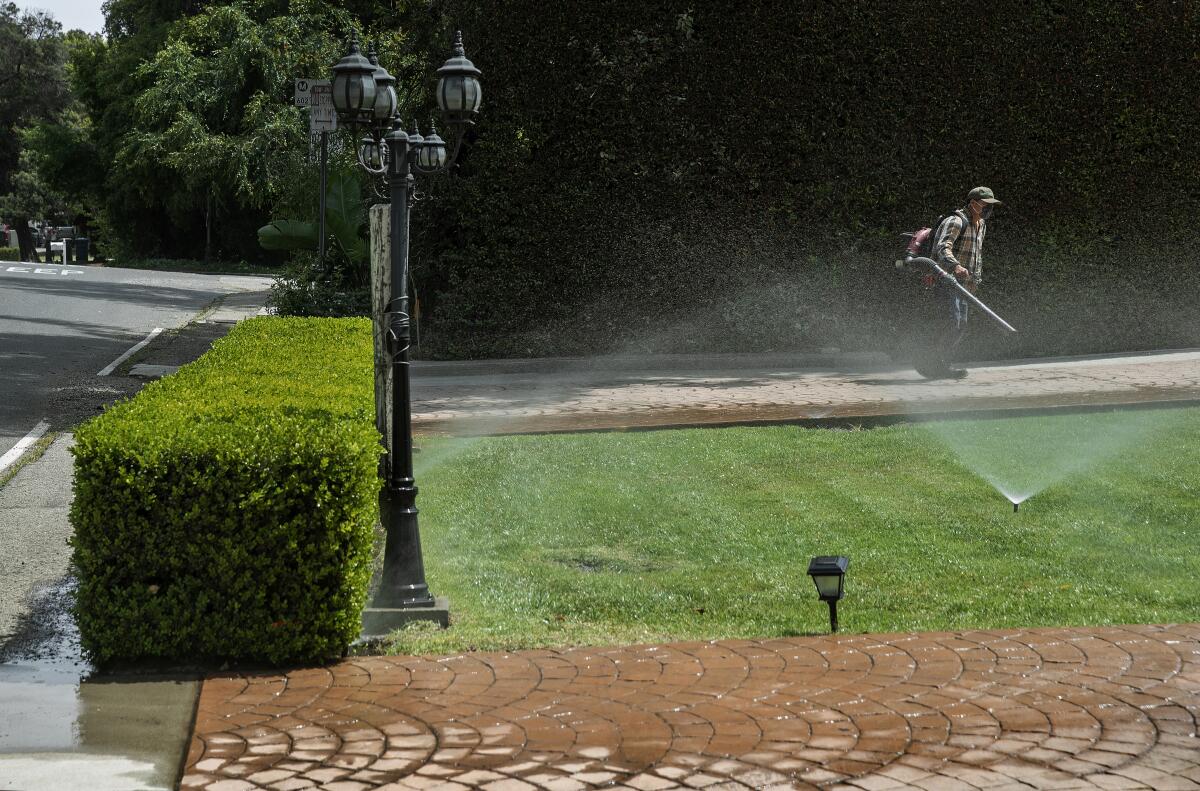
- Share via
Major water restrictions are about to take effect in areas ranging from Rancho Cucamonga to Thousand Oaks, and Baldwin Park to North Hollywood. But many nearby areas will escape the mandatory one-day-a-week watering limits — among them Santa Monica, Long Beach, Torrance and Beverly Hills.
Why? The Metropolitan Water District of Southern California has targeted these first-ever water restrictions for areas that rely heavily or entirely on the State Water Project — a Northern California water supply that officials say faces a real risk of running dry. Areas that receive water from the Colorado River and other sources will be spared — at least for now.
It’s a strategy whose wisdom has divided experts. While some say it reflects the realities of California, others say it ignores the possibility that the drought could continue for another year, among other concerns.
Managers of the nation’s largest urban water wholesaler said the shortage emergency is so serious that they have no option but to require an immediate 35% cut in water use to preserve enough supplies for people to cover basic needs indoors.
“Imagine a day when you open your tap and no water’s coming out. That’s going to be the worst emergency, worse than anything that you’ve ever seen,” said Adel Hagekhalil, the district’s general manager. “Water is essential for the economy, water is essential for public health, water is essential for our livelihood … People need to know that this water is not just something that we can waste.”
All or part of these cities and communities are dependent on water from the State Water Project and will be affected by new watering restrictions.
The restrictions are due to start June 1 and will apply to nearly 6 million people across Ventura and northwestern L.A. counties and parts of the San Gabriel Valley and the Inland Empire, about one-third of the areas where the MWD supplies imported water.
Areas that won’t face the restrictions include many cities across Southern California that receive substantial amounts of water from the Colorado River or other sources. The difference in these areas, MWD spokesperson Rebecca Kimitch said, is that “they are getting sufficient Colorado River supplies or local supplies to meet demand.”
Some water experts, however, said they think similar restrictions should apply throughout the MWD’s service area because the Colorado River is also suffering a first-ever shortage.
“The real question is, why not just do it for the entire service area?” said Felicia Marcus, a researcher at Stanford University’s Water in the West Program and former chair of California’s state water board. “It may be most acute for these particular areas in this particular year, but I think increasingly we have to take a longer view than we’re used to.”
For the first time ever, Southern California water officials will limit outdoor watering to just once a week in certain areas beginning June 1.
Marcus said she thinks the MWD should go “more all-out to avoid even deeper restrictions in future dry years,” because next year could be similarly dry. Not cutting back across the board throughout the region, she said, is like “high-stakes gambling.”
“It’s hard to deny that we’re in dire straits. And it’s hard to deny that climate makes what was already a variable crapshoot year to year much more risky,” Marcus said. “It’s prudent to act sooner rather than later. I just think wishful thinking should go out the window, and we need to take more dramatic action.”
Though California’s urban water suppliers have yet to face large cuts in deliveries from the Colorado River, that could change as the river’s reservoirs, which are already at their lowest recorded levels, continue to drop.
Lake Mead, the largest reservoir on the Colorado River and in the nation, has fallen so low that an original 1971 water intake is now exposed.
The decision to restrict outdoor watering to one day a week for millions of Southern Californians could presage even stricter actions in September.
Yet some experts said the MWD’s plan makes sense, particularly since it avoids a “one size fits all” approach that might not account for local and regional differences. While some agencies can draw from other water sources in their portfolios, others are much more limited and may need stronger measures, said Glen MacDonald, a UCLA distinguished professor of California and the American West.
“The strategy reflects the realities of California. There’s different water sources throughout the state, and different dependencies on those water sources,” MacDonald said. “If everyone understands how serious this is, and then they enact policies which reflect the reality of their specific regional area, that’s the best way forward with this.”
Still, he said, that reliance on the Colorado River is more of a Band-Aid than a solution, particularly amid the worsening climate crisis.
The river is “a fallback, but it’s one of diminishing usefulness. If you were to put all your eggs in that basket, it’s not going to carry you through for the long-term,” McDonald said, adding that “with continued climate change, we’re going to have higher temperatures, more evaporation, probably a much more variable precipitation regime. It’s like we’re in the middle of a train wreck, and it’s a climatic train wreck.”
For the time being, the Colorado River is proving an invaluable resource for areas like Beverly Hills. The city doesn’t face the new MWD restrictions because it is “fortunate to have access to Colorado River water that other communities in the latest order do not,” Public Works director Shana Epstein said.
Santa Monica, too, is not covered by the latest order. The city gets about 60% of its supply from local groundwater, while 40% is purchased from the MWD via either the Colorado River or the State Water Project, according to water resources manager Sunny Wang.
That flexibility was largely by design, Wang said. Since the previous drought, Santa Monica has spent more than $200 million on local water supply projects to reduce its reliance on imported supplies, including investments in stormwater harvesting and increased efficiency at the city’s brackish groundwater desalination facility, among other projects.
The funds needed for those kinds of improvements could prove challenging for some cities. Wang said the $200 million came from a combination of grant money, loans and water revenue bonds.
Hagekhalil, the MWD’s general manager, said the self-reliance of some areas is why the “one size fits all” approach doesn’t work. It also underscores the need for “real investments in recycled water, real investments in stormwater capture, real investments in storage.”
“These are critical,” he said. “We can’t conserve our way out of this.”
Large portions of Southern California are being told to water outdoors just one day a week. And a total watering ban could be imposed by fall.
Even within the scope of the MWD’s order, there are exceptions. People will still be allowed to hand-water trees to keep them alive, and there is also an exemption to allow for drip irrigation systems, or other high-efficiency irrigation, to “apply water at a weekly volume consistent with the one-day watering restriction imposed on less efficient irrigation systems,” according to the MWD.
For the record:
11:11 a.m. April 29, 2022A previous version of this article misidentified Shahzeen Attari as an assistant professor at Indiana University Bloomington. Attari is an associate professor.
Shahzeen Attari, an associate professor at Indiana University Bloomington who studies human behavior and resource use, said that focusing cuts on the most jeopardized areas makes sense from a policy perspective, at least for the time being.
But leaving too much decision-making to local and regional authorities could create “something similar to what happened with COVID and the mask mandates, where there’s a sort of mishmash of different rules for different people,” she said.
What’s more, the combination of “problem fatigue” stemming from the COVID-19 pandemic, the war in Ukraine, inflation and other pressing issues could make it challenging to drive home the severity of the situation — and get 100% compliance from people who feel as though they’ve already stepped up conservation since the previous drought, she said.
“They did quite a bit last time around, so they might have maintained those behaviors and might not know what to do now,” she said.
There are other lingering questions too, including, crucially, whether any of this will work.
Californians so far have been sluggish in their response to the current drought, and in fact increased residential water use at the start of the year despite pleas from Gov. Gavin Newsom for voluntary reductions.
According to the MWD, it will fall to each member agency to determine how best to implement the restrictions. Some, such as Las Virgenes Municipal Water District, have already spelled out detailed plans for enforcement and patrol; others, including the Los Angeles Department of Water and Power, are still working on the details.
Once each local agency adopts its new rules, the MWD has said outdoor watering should be limited to one day per week. Or, alternatively, each water supplier can adopt another approach to achieve the overall 35% reduction. The MWD plans to track agencies’ progress and could fine any that don’t cut back enough.
In developing water conservation rules, “it’s better to do them across the board, just because it causes less confusion and sort of homogenizes the approach,” said Newsha Ajami, a water researcher at Lawrence Berkeley National Laboratory.
Ajami said she’d like to see the restrictions be more focused on reducing per-capita water use to a certain target, which she said is a much better strategy than focusing on percentages.
“That way, you know across-the-board everybody is reducing their outdoor water use,” Ajami said, “and can create a collective action around that.”
Californians are well-acquainted with the need to save water. Here are some practical tips to cut your water use, plus a look at the big picture.
